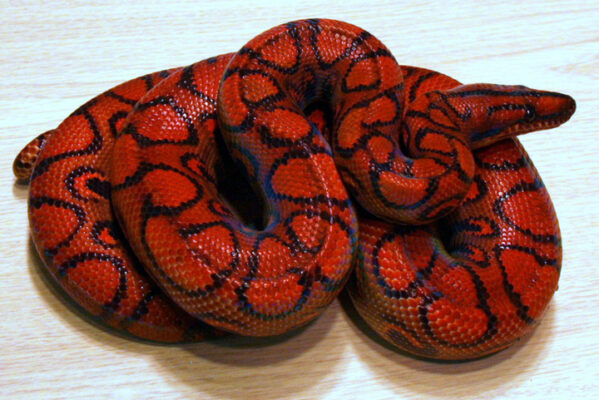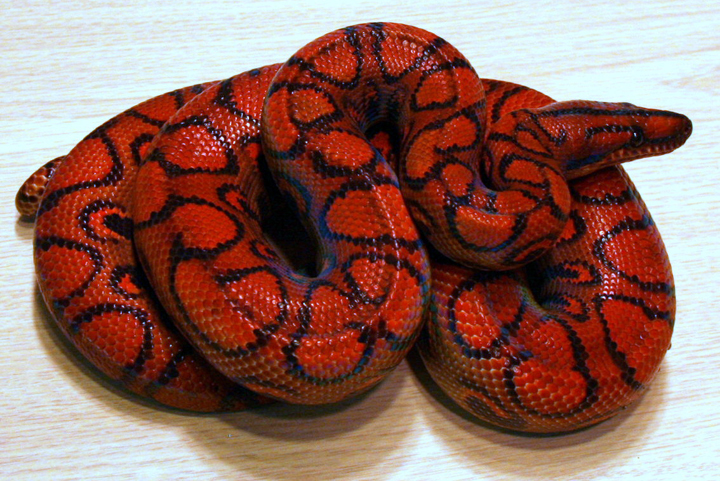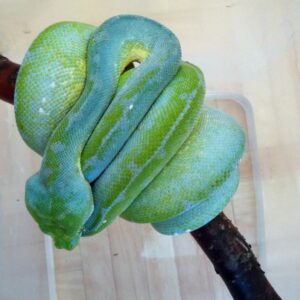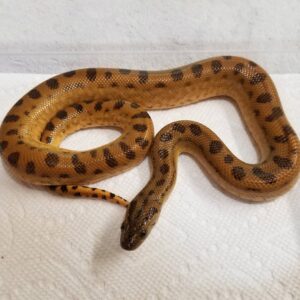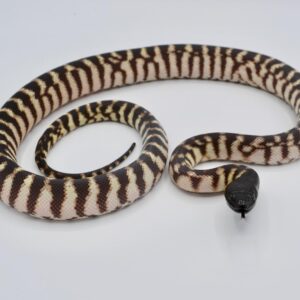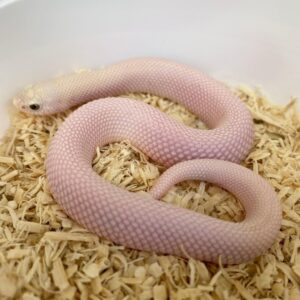Brazilian Rainbow Boa For Sale
$600.00
The Brazilian Rainbow Boa, as its name suggests is among the most stunning snake species on planet.
However, its name comes because of a highly iridescent light that seems to provide all colors that is in rainbow.
The Brazilian Rainbow Boa is able to reach 5-6 feet in height. If properly cared for and fed, it can reach six and a half inches.
In terms of their needs for care They have fairly simple requirements since they don’t need an exact temperature or lighting. food is only required every other week. However, their personality is either shy or aggressive, and they’re not the ideal pet for a beginner.
Size
The boas just born are 12-20 inches in length.
In a single year, they increase by 35-40 inches.
The average adult height is 5-6 feet.
If they are given the best nutrition and care they could grow in height of 6.5 feet.
Lifespan
Brazilian Rainbow Boa In the natural environment boas live around 10 years. In enclosures they can live to 20 years as there is no chance of predation .
Summary Table
| Scientific Name: | Epicrates Cenchria |
|---|---|
| Common name: | Brazilian rainbow boa, slender boa |
| Lifespan: | 20 years |
| Diet: | Large-sized mice and rats (dead or thawed), birds, fowl |
| Adult size/weight: | 5-6 feet and up to 4,00 grams |
| Tank size: | 6X2X2 feet glass vivariumterrarium |
| Temperature: | 72℉ to 86℉ |
Description
The Brazilian Rainbow Boa (Epicrates cenchria) is a species of non-venomous snake renowned for its striking appearance and captivating iridescence. Belonging to the Boidae family, this snake is a subject of fascination among herpetologists and reptile enthusiasts alike. Originating from the lush rainforests of South America, particularly those in Brazil, the Brazilian Rainbow Boa thrives in humid, tropical environments.
One of the most distinctive physical attributes of the Brazilian Rainbow Boa is its iridescent sheen, which is the result of microscopic ridges on its scales that refract light, creating a rainbow-like effect. This unique feature not only contributes to its name but also makes it one of the most visually stunning reptiles in the world. The base coloration of these boas can range from reddish-brown to orange, adorned with dark, circular patterns along their bodies.
In terms of scientific classification, the Brazilian Rainbow Boa is categorized under the genus Epicrates and the species cenchria. These snakes typically grow to lengths of 5 to 7 feet, with females generally being larger than males. Their robust and muscular bodies are well-adapted to their arboreal and terrestrial habitats, allowing them to navigate through dense foliage and forest floors with ease.
The natural habitats of the Brazilian Rainbow Boa encompass a variety of ecosystems within South America, extending from the rainforests of Brazil to neighboring regions. They are often found in areas with high humidity and ample cover, such as riverbanks, swamps, and tropical forests. This adaptability to different environments highlights their resilience and versatility as a species.
Understanding the Brazilian Rainbow Boa’s physical characteristics and natural habitats is essential for appreciating its role in the ecosystem and the importance of its conservation. As we delve deeper into the enchanting world of this remarkable snake, we will explore its behavior, diet, and the challenges it faces in the wild.
Habitat and Natural Environment
The Brazilian Rainbow Boa, renowned for its iridescent scales, thrives in diverse habitats across South America. These snakes predominantly inhabit tropical rainforests, where the environment offers the optimal conditions for their survival. The humid, warm climates of these regions are essential for maintaining the health and well-being of the Brazilian Rainbow Boa.
Humidity levels in their natural habitat range between 75% and 95%, a necessity for their proper skin shedding and overall hydration. These high humidity levels are typically found in dense, lush forests which provide ample cover and moisture. The temperature in these areas usually fluctuates between 75°F (24°C) at night and 85°F (29°C) during the day, creating a warm and stable climate conducive to their lifestyle.
Geographically, the Brazilian Rainbow Boa is most commonly found in Brazil, but its distribution extends to other parts of South America, including Venezuela, Guyana, Suriname, French Guiana, and Peru. Within Brazil, they are often located in the Amazon Basin, one of the most biodiverse regions on the planet. This area provides an ideal environment with its extensive river systems and dense canopies, which offer both humidity and a variety of prey.
The vegetation in these habitats is typically characterized by thick underbrush and a variety of trees, offering the Brazilian Rainbow Boa numerous hiding spots and hunting grounds. These snakes are semi-arboreal, meaning they spend time both on the ground and in the trees, making the vertical structure of the forest an important aspect of their habitat. The combination of high humidity, moderate temperatures, and rich vegetation ensures that the Brazilian Rainbow Boa can thrive, exhibiting their natural behaviors and maintaining their health.
Understanding the specific environmental requirements of the Brazilian Rainbow Boa is crucial for conservation efforts and for those who wish to keep these captivating creatures in captivity. Replicating their natural habitat as closely as possible can help ensure their longevity and well-being.
Physical Characteristics and Behavior
The Brazilian Rainbow Boa (Epicrates cenchria) is renowned for its striking appearance and unique physical attributes. Typically, these snakes can reach lengths of 5 to 7 feet, although some individuals may grow even longer. Their bodies are robust and muscular, designed for both climbing and ground movement. One of the most distinguishing features of the Brazilian Rainbow Boa is its vibrant coloration. These snakes exhibit a rich palette of reddish-brown to orange hues, adorned with black or dark brown dorsal blotches. This coloration provides excellent camouflage in their native habitats, which include the forests and savannas of South America.
What truly sets the Brazilian Rainbow Boa apart is the mesmerizing iridescence of its scales. Under direct light, the scales refract light in a manner that produces a rainbow-like sheen, giving the snake its common name. This iridescence is due to microscopic ridges on the scales that act like prisms, breaking the light into various colors. This not only adds to their allure but may also play a role in communication and mating displays.
In terms of behavior, the Brazilian Rainbow Boa is primarily nocturnal. It spends the daylight hours hidden in burrows, under foliage, or within tree hollows, emerging at night to hunt. Its diet in the wild mainly consists of small mammals, birds, and occasionally reptiles. The snake utilizes both constriction and ambush tactics to capture its prey. With its keen sense of smell and heat-sensing pits, the Brazilian Rainbow Boa is an efficient and stealthy predator.
Additionally, these boas are known for their generally docile nature, particularly in captivity. They are solitary creatures, coming together only during mating season. Understanding these physical and behavioral characteristics is crucial for anyone interested in the care and conservation of the Brazilian Rainbow Boa, as these attributes directly influence their habitat needs and overall well-being.
Reproduction and Lifespan
The Brazilian Rainbow Boa exhibits a fascinating reproductive cycle characterized by distinct stages. Mating typically occurs during the rainy season, which provides optimal conditions for the species. Courtship behaviors include the male following the female, often engaging in tactile stimulation by rubbing against her. Once successful copulation occurs, the female enters a gestation period lasting approximately 120 to 150 days. During this time, the female will seek out a warm, secluded environment to ensure the development of her offspring.
Brazilian Rainbow Boas are ovoviviparous, meaning they give birth to live young rather than laying eggs. A single litter can consist of anywhere from 12 to 35 neonates, each measuring around 15 to 20 inches in length. These juveniles are precocial, meaning they are relatively mature and self-sufficient at birth, requiring minimal care from the mother. However, the survival rate of these young boas can be influenced by environmental factors such as temperature, humidity, and availability of food.
In the wild, Brazilian Rainbow Boas have an average lifespan of 10 to 15 years. However, when kept in captivity under optimal conditions, they can live significantly longer, often reaching 20 years or more. Factors that contribute to their longevity in captivity include consistent access to appropriate nutrition, controlled environmental conditions, and regular veterinary care. Conversely, in the wild, their lifespan may be curtailed by threats such as predation, habitat loss, and disease.
Understanding the reproductive and lifespan dynamics of the Brazilian Rainbow Boa is essential for both conservation efforts and responsible pet ownership. Ensuring that these snakes are provided with environments that closely mimic their natural habitats can promote their well-being and longevity, whether they are in the wild or in captivity.
Care and Husbandry in Captivity
Maintaining Brazilian Rainbow Boas in captivity requires meticulous attention to their habitat, diet, and overall health. A well-crafted tank setup is fundamental for their well-being. Ideally, an enclosure should measure at least 36 x 18 x 18 inches for a single adult boa, providing ample space for movement. Glass or plastic enclosures are preferred due to their ability to retain humidity, a crucial factor for this species. Substrates like coconut husk or cypress mulch are recommended, as they mimic the natural environment and help maintain humidity levels.
Temperature control is another critical aspect. A temperature gradient should be established, with a basking area maintained around 88-92°F and a cooler side ranging from 75-80°F. This allows the snake to regulate its body temperature effectively. Nighttime temperatures can safely drop to 70-75°F. Humidity levels should be kept between 70-80%, replicating the Brazilian rainforest’s humid conditions. Regular misting and the use of humidifiers or foggers can aid in achieving these levels.
Feeding schedules for Brazilian Rainbow Boas should be consistent but not excessive. Juveniles typically require feeding every 5-7 days, while adults can be fed every 10-14 days. Prey items should be appropriately sized, generally no larger than the snake’s girth. Frozen-thawed rodents are the most common diet and should be offered using tongs to prevent accidental bites.
Vigilance in health monitoring is essential. Common health issues include respiratory infections, often caused by inadequate humidity or temperature, and mites, which can be introduced via contaminated substrate or other animals. Regular check-ups with a herpetologist and maintaining a clean habitat can prevent these problems. Observing the snake’s behavior and physical condition will also provide early indicators of potential health issues.
Conservation Status and Threats
The Brazilian Rainbow Boa (Epicrates cenchria) is a species that captures the fascination of many, owing to its striking appearance and unique iridescent scales. Despite their allure, these snakes face several threats in the wild that have implications for their conservation status. The International Union for Conservation of Nature (IUCN) currently lists the Brazilian Rainbow Boa as “Least Concern.” However, this classification does not imply the absence of threats to their existence.
Habitat destruction remains a significant concern for the Brazilian Rainbow Boa. The rapid deforestation of the Amazon rainforest, driven by logging, agriculture, and urban expansion, has severely fragmented their natural habitat. This loss of habitat not only reduces the available area for these snakes to live and hunt but also isolates populations, making it difficult for them to find mates and maintain genetic diversity.
Another notable threat to the Brazilian Rainbow Boa is the illegal pet trade. These snakes are highly sought after for their beauty and docile nature, making them a target for wildlife traffickers. The capture and sale of wild-caught individuals can lead to population declines and disrupt local ecosystems. Moreover, the conditions under which these snakes are often transported and sold can be inhumane, leading to high mortality rates.
Conservation efforts to protect the Brazilian Rainbow Boa are underway by various organizations. Initiatives include habitat preservation, anti-poaching measures, and public education campaigns aimed at reducing the demand for wild-caught specimens. Noteworthy organizations such as the World Wildlife Fund (WWF) and local Brazilian conservation groups are actively involved in these efforts. They work to enforce stricter regulations on the pet trade and promote sustainable practices that benefit both the wildlife and the indigenous communities.
While the Brazilian Rainbow Boa is not currently at imminent risk of extinction, continuous monitoring and conservation actions are crucial. Protecting their natural habitats and curbing illegal trade are essential steps to ensure that these mesmerizing reptiles continue to thrive in the wild.
Interesting Facts and Myths
The Brazilian Rainbow Boa, renowned for its iridescent scales, is a captivating creature that has fascinated both scientists and enthusiasts alike. One of the most intriguing aspects of this snake is its exceptional sensory adaptations. Unlike many other reptiles, the Brazilian Rainbow Boa possesses heat-sensing pits along its upper lip, which enable it to detect warm-blooded prey even in complete darkness. This adaptation is crucial for its survival in the dense rainforests of South America, where visibility is often limited.
Another noteworthy behavior of the Brazilian Rainbow Boa is its method of locomotion. Despite being primarily terrestrial, these snakes are also adept climbers and swimmers. They often traverse trees in search of prey or to avoid predators, showcasing their remarkable versatility in various environments. Their diet primarily consists of small mammals, birds, and occasionally amphibians, highlighting their role as both predator and prey within the rainforest ecosystem.
In South American folklore, the Brazilian Rainbow Boa holds significant cultural importance. Various indigenous tribes revere these snakes as symbols of fertility and renewal, often featuring them in traditional stories and rituals. However, not all beliefs surrounding the Brazilian Rainbow Boa are based on fact. One common myth is that these boas are venomous, a misconception likely stemming from their formidable appearance. In reality, Brazilian Rainbow Boas are constrictors, subduing their prey by coiling around them and exerting pressure until the prey succumbs.
Another prevalent myth is that these snakes are aggressive towards humans. While any wild animal can exhibit defensive behavior if threatened, Brazilian Rainbow Boas are generally known for their docile nature, especially when compared to other snake species. Proper handling and respect for their natural habitat are key to maintaining a harmonious coexistence with these magnificent reptiles.
Understanding the true nature of the Brazilian Rainbow Boa not only dispels unfounded fears but also fosters a greater appreciation for the biodiversity of our planet. These snakes, with their unique adaptations and cultural significance, continue to enchant and inspire those who take the time to learn about them.
Conclusion and Final Thoughts
The Brazilian Rainbow Boa, with its mesmerizing iridescent scales and unique behavioral traits, stands out as one of the most captivating reptiles in the animal kingdom. Throughout this blog post, we have delved into various aspects of this species, from its distinctive physical features to its natural habitat and diet. Understanding these elements is crucial not only for enthusiasts and researchers but also for anyone interested in the intricate balance of our ecosystems.
One of the most striking aspects of the Brazilian Rainbow Boa is its ability to thrive in diverse environments, ranging from humid rainforests to dry savannas. This adaptability highlights the species’ resilience but also underscores the importance of preserving their natural habitats. Deforestation and habitat destruction pose significant threats to the Brazilian Rainbow Boa, making conservation efforts imperative for their continued survival.
Moreover, the Brazilian Rainbow Boa plays a vital role in its ecosystem. As a predator, it helps control populations of small mammals and birds, ensuring a balanced food web. This predatory role is essential for maintaining the health of the ecosystem, demonstrating the interconnectedness of various species within their habitats. Protecting the Brazilian Rainbow Boa, therefore, means safeguarding the broader environment and the myriad species that depend on it.
For those captivated by the beauty and mystery of the Brazilian Rainbow Boa, further exploration and education are highly encouraged. By learning more about these fascinating reptiles, we can better appreciate their significance and advocate for their protection. Whether through supporting conservation initiatives or spreading awareness, every effort counts in preserving the enchanting world of the Brazilian Rainbow Boa.
